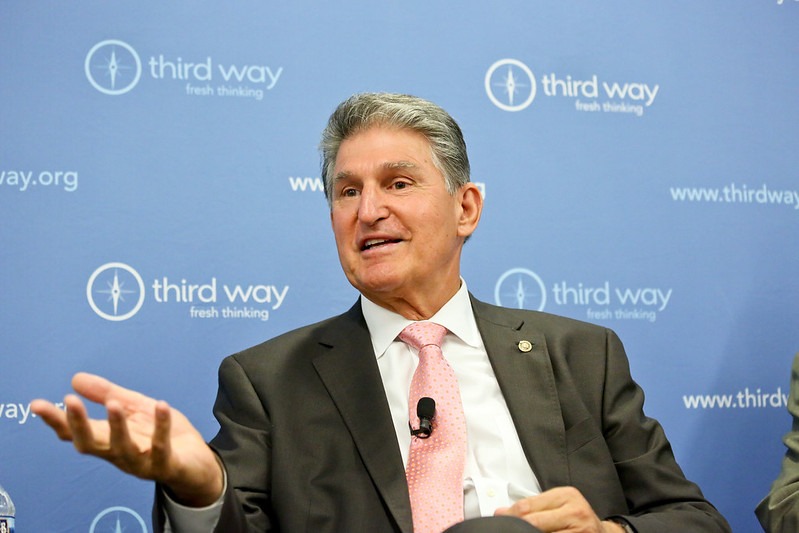Because Senator Joe Manchin of West Virginia insisted that Democrats walk back many of the critical climate protection measures in President Biden’s legislative agenda, the United States will, ironically, lose a historic opportunity to reduce carbon dioxide emissions while at the same time retaining the jobs of the 14,000 West Virginia coal miners whose livelihoods Manchin in theory has been trying to protect.
Among the deleted items in the Clean Energy Performance Program (the CEPP contains the climate provisions in Biden’s Build Back Better legislation), was the budget line that could potentially lead to funding for pyrolysis, a process that converts organic material like coal into a synthetic gas. The gas can then be reduced to its simplest chemical compounds and elements: water, solid carbon (biochar), and hydrogen.
Further, by casting pyrolysis funding aside, the Senate is undercutting American leadership at the upcoming U.N. Climate Change Conference of the Parties, or COP26, in Glasgow, making it harder for the United States to send a strong signal to other leading producers of CO2 to make and follow through on commitments to reduce carbon in the atmosphere.
Despite well-documented logistical and technical hurdles, conversion to the hydrogen economy is often viewed as the pathway with the most potential to achieve carbon-neutral equitable economic growth. This conversion is also the most effective way to curb global warming for the 11.5 billion people who will populate the earth by 2100.
Across Europe, China, Canada, parts of South America, and the United States, there are ambitious plans to migrate away from hydrocarbons (the chief components of petroleum and natural gas) for generating energy and fueling transportation. In the United States, the Defense Department is converting domestic military bases to hydrogen-powered fuel cells (which combine hydrogen and oxygen to produce electricity, with water and heat as by-products), issuing hydrogen batteries for complex military equipment, and testing hydrogen-powered drones.
BMW, Toyota, and Honda have developed and now sell hydrogen-powered cars. There are several global companies manufacturing hydrogen-powered buses and heavy trucks and incorporating hydrogen as a marine fuel.
According to the Fuel Cell and Hydrogen Energy Association—an organization that advocates for the use of hydrogen-generated electricity—in 2020, excluding military installations, there were 550 megawatts of electricity produced using stationary hydrogen fuel cells. Though at this point this is an infinitesimally small segment of U.S. power generation, it is produced by environmentally forward-leaning market and thought leaders like Google, Apple, Coca-Cola, Amazon, and Microsoft, who are setting the pace for change in the United States.
As stringent European CO2 reduction requirements are being enforced, European steelmakers are turning to hydrogen to manufacture steel. To solve the problem of variability of solar and wind-generated power for the grid, hydrogen is ultimately a superior solution for energy storage than even the most efficient lithium battery technology. Though hydrogen is all around us, literally and figuratively, full-scale deployment for energy generation and storage remains beyond the horizon.
The current slow migration to hydrogen can potentially be accelerated by coal and other hydrocarbon extraction workers in West Virginia using pyrolysis for coal gasification. The gas is created by heating pulverized coal to 1,000 degrees Celsius in a vacuum chamber. At this high temperature, the process converts the coal into a synthetic gas that can be separated into hydrogen, clean water, and biochar, all of which have alternative uses that don’t contribute to greenhouse gases in the atmosphere. The hydrogen can be used for generating electricity in fuel cells. The clean water can be used for anything that requires clean water, and the biochar can be used as concrete filler or street paving, or converted into carbon filament for strengthening other materials.
Instead of thinking about migrating away from coal for power production, we should be thinking of using coal as a bridge to the clean energy hydrogen economy. Instead of eliminating coal mining jobs in West Virginia, the Biden administration should be investing in the development of pyrolysis process plants, fuel cells, and smart-grid power transmission infrastructure in West Virginia. These coal-to-green-infrastructure investments can produce and distribute carbon-free electric energy to the national electrical grid, which will also be modernized and upgraded by CEPP.
The Build Back Better investments in smart grid and the incentives for utility companies to convert to renewable energy should be paired with investment in the technology to convert coal into a hydrogen energy source in coal country. These investments will preserve and perhaps even grow jobs in the coal mining industry and process industry. West Virginia, which has long been a chemical and polymer industry hub, has a tech workforce with the requisite skills to design and operate pyrolysis process facilities. The required investment will grow skilled, good-paying jobs in the extraction industry, the process industry, and the power distribution and generation industries in coal country.
Many environmentalists believe conversion to the green hydrogen economy is the gold standard for how we should continue to supply the earth’s energy needs without accelerating climate change. Because the technology that we have for generating hydrogen from water is not yet viable, we cannot afford to sit on our hands awaiting the perfect solution.
Although pyrolysis and fuel cell technology are well established and can be advanced more rapidly to scale, without government investment and incentives the cost to produce electricity from coal-sourced hydrogen is more than the free market can bear. Still, in the same way that solar tax credits accelerated the adoption of solar cells, the government has the capacity to accelerate the conversion to the hydrogen economy without leaving coal miners and other extraction-sector jobs on the chopping block.
We can all win. Public funding for pyrolysis can be a yes vote for the miners in West Virginia who have often been overlooked, as their industry is stigmatized and their livelihoods have been eroded by tougher environmental regulations and market forces. A yes vote will be a vote for a more sustainable future for ourselves and future generations. With a few billion dollars of investment in hydrogen energy production through pyrolysis, we can reduce CO2 and we can save and create jobs. As an intermediate step, this option is a far better choice than doing nothing at all, the option that the political system for the time being has delivered.
Carlton Brown, CEO of Direct Invest Development, is a developer of restorative human settlements. He is a board member of the Institute for Market Transformation, a nonprofit focused on decarbonization; a board member of Global Green USA; and an adjunct associate professor at the Pratt Institute Program in Sustainable Environmental Systems.




Professor Carlton Brown, has clearly and succinctly mapped a clear analysis of our global environmental issues, and how we in our country should go about solving this unavoidable problem. Climate control is far too important to continue to ignore with business as usual. This analysis gets right to the heart of the matter. I think it’s excellent, many of should support this writer’s point of view.